Cork is home to some of Ireland’s most popular tourist attractions such as the Blarney Stone, Fota Wildlife Park, Garnish Island and the Old Midleton Distillery.
In 2005, Cork was the European Capital of Culture and the city attracted over one million visitors to the various events that were held throughout the year.
Cork is situated on the south coast of Ireland. Visitors enjoy the atmosphere in the bustling city and the numerous attractions there are to see.
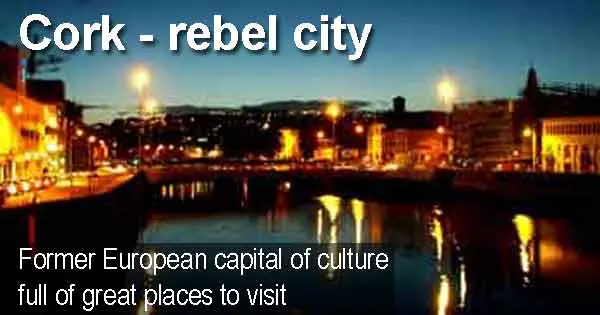
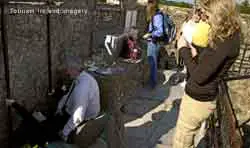
The Blarney Stone
The Blarney stone is famous all over the world. It is said to possess mystical powers and can give anyone who kisses it the ‘gift of the gab’. That is the ability to smooth talk your way in to or out of any situation.
The Blarney Stone is built into Blarney Castle.
More on the Blarney Stone and Blarney Castle
Fota Wildlife Park

Fota Wildlife Park is one of the top ten tourist attractions in Ireland, and the most popular in Cork.
It is home to thousands of animals and plants. Some of the species in the park are native to Ireland while many are more exotic. Animals such as gorillas, cheetahs, flamingos, kangaroos, zebras, pelicans, emus giraffes and many more can be seen.
There is plenty of information about all the animals on the Park’s website.
The English Market
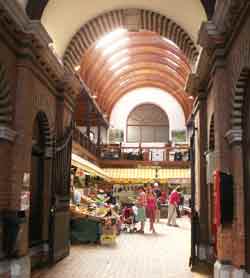
The English Market is the most famous covered food market in Ireland. It was established in 1788 and is made up of both Princess Street Market and Grande Parade Market.
It is a famous for its selections of quality meat and fish but all kinds of food are available. The stalls offer the freshest locally sourced produce and over the last 30 years the market has become more multicultural.
The market attracts tourists from all over the world including Queen Elizabeth who visited in 2011.
In the 1800s, the market was given its name to distinguish it from another market nearby that was known as the Irish Market.
The market was badly damaged in a fire in 1980 and was refurbished to the original Victorian design.
Beamish and Crawford Building
It’s like stepping back in history…
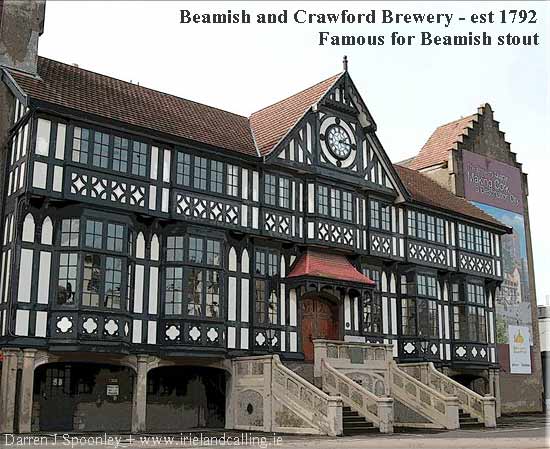
The building is in the heart of Cork’s medieval city. The brewery has had many owners, and is now owned by Heineken International. This brewery closed in March 2009 with the loss of 120 jobs, with production moving to the Heineken Brewery.
The Ewe Sculpture Gardens
The Ewe Sculpture Gardens are a unique and eccentric mixture of art and nature. There are a number of gardens, with beautiful, exotic plants, and creative sometimes humorous sculptures that are placed throughout the site.
The sculptures and all the artworks indoors and outdoors are by artist, Sheena Wood, who runs the gardens with her husband, Kurt. The gardens are at the couple’s home.
The sculptures are of various animals including sheep, rhinos, pigs, fish and birds as well as people. There are also several artistic ornamental sculptures.
The Gardens feature ‘ewe create’ areas where visitors can create their own sculptures using sticks and stones. The ‘Ewe create’ area indoors is a bead workshop where visitors can make jewellery.
Blackrock Castle observatory
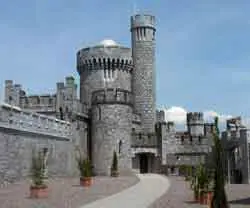
As medieval castles go, Blackrock Castle is rather unique. Like many castles, it has a history as a fort to defend the city against invaders, in Cork’s case the invaders would have been pirates.
However, unlike most castles, Blackrock Castle is a place that encourages visitors to embrace science as well as history. It is home to the first interactive astronomy centre in Ireland.
The centre has a radio telescope, floor to ceiling screens for displays and an optical telescope. The optical telescope looks for signs of intelligent life in the cosmos by searching for tiny flashes of light that may only last for a billionth of a second.
There is also a ‘social software’ cinema screen in which visitors can help to design a space mission to stop a comet smashing into Earth.
As well as looking into space, visitors can also take a tour of the tower and dungeon of the castle and learn about its history.
St Finbarr’s cemetery
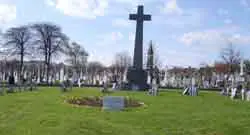
St Finbarr’s cemetery is one of the biggest cemeteries in Cork and is the final resting place of many Irish Republicans who lost their lives in fighting for Irish independence.
Well known people buried there include Joseph Murphy, who died after 76 days on hunger strike in 1920, Jack Lynch, who was Taoiseach between 1977-79, poet and composer Arnold Bax.
There are commemorations at the cemetery to remember the 1916 Easter Rising very Year on Easter Sunday.
Garnish Island

Garnish Island is a short boat ride away and is home to some beautiful gardens. There are exotic plants from various climates from all over the world.
Crawford Art Gallery
The Crawford Art Gallery has over 2000 works in its permanent exhibitions. They are mainly by Irish or European artists from the 18th century up to the modern day. There are various mediums such as paintings, sculptures and video installations.
There are always temporary exhibitions on display as well as events to keep people coming back.
The Crawford Art Gallery is one of Ireland’s key cultural institutions and attracts over 200,000 visitors every year.
Red Abbey
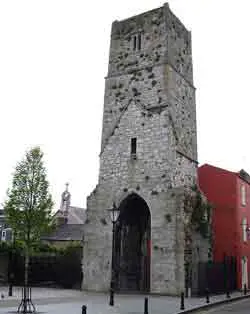
Visitors to Cork can see the remains of an Augustinian abbey from the 13th or 14th century. Despite suppression of Catholics, the friars occupied the abbey until the 17th century.
In 1690, the Abbey was used by John Churchill in the Siege of Cork.
Cork came under siege from the British who wanted to suppress a campaign to see catholic former king, James II reclaim the throne after he had been overthrown by William III.
There was a fire in the abbey in 1799 which saw much of the structure damaged. Today the bell tower is the only part of the abbey that remains. It is listed as a national monument.
Cork City Gaol
The Cork City Gaol used to be a jail in the 19th century. Today it is open to visitors and gives a fascinating insight into the lives of the prisoners of the time. There are audio/visual presentations and models of the inmates in the cells around the prison.
The prison is a fantastic Georgian/Gothic castle-like building surrounded by huge walls to stop inmates from escaping. In the 1800s, criminals would often be held at Cork City Gaol before being transported to Australia.
Many Irish nationalists were imprisoned at the Gaol, including Countess Markievicz. Markievicz was the first female MP to be elected into the British House of Commons although as a member of Sinn Féin who had abstained from British policies, she never took her seat.
She was incarcerated numerous times in jails all over Ireland and Britain for nationalist activities such as her part in the Easter Rising.
The prison closed in 1923 and the building was used as a base for a radio station. The radio station shut down in 1958 and the building became a post office until the 1980s. In 1993, it was restored to how it had been as a prison and opened for public viewing by Micheál Martin, the Mayor of Cork.
Lewis Glucksman Gallery
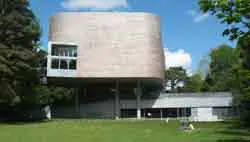
The Lewis Glucksman Gallery is in the University College, Cork. It is an award winning gallery with hundreds of pieces of art in it collection.
The gallery is focused on Irish contempary art and has paintings, sculptures, photographs and prints from several well known Irish artists. Barrie Cooke, Maud Cotter, Paul Seawright, Clare Langan, Brian O’Doherty all have work on display.
The works are situated throughout the university which gives visitors a chance to see the campus as they take in the art. There are also temporary exhibitions and events.
Cobh

Cobh is a seaside town on the south coast of Co Cork. As well as the harbour, there are a number of attractions.
It is home to the Titanic experience which tells the story of the ship’s maiden voyage from the point of view of the Queenstown passengers – Cobh was known as Queenstown at the time of the voyage. The Titanic experience is a situated in the original offices of the White Star Line, which is where the final 123 passengers boarded the Titanic.
There is a statue of Annie Moore and her brothers at Cobh Harbour. On Moore’s 15th birthday she became the first immigrant to pass through the Ellis Island facility in New York Harbour.
She left Ireland from Cobh Harbour and arrived on the steamship Nevada with her two younger brothers on 1st January 1892. There is another statue of Moore at Ellis Island.
Cobh is a great place to relax; there are plenty of friendly pubs and popular fishing spots.
Old Midleton Distillery
The Old Midleton Distillery is where Jameson made their famous whiskey until 1975 before moving to a new distillery.
The old building is now home of the Jameson Experience. Visitors can take a guided tour and see the old kilns, mills, malting, water wheel, the still house, warehouses and distillers cottage. Some of the buildings date back to the 18th century.
At the end of the tour, visitors are given a complementary glass of whiskey. They then have the opportunity to buy some Jameson whiskey and merchandise at the Jameson shop. There is also a restaurant to relax and enjoy an ‘Irish’ coffee.
You can also book a session of whiskey tasting where a tutor will teach you to distinguish between Irish, Scotch and Bourbon whiskey.
Spike Island
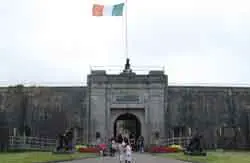
Spike Island is a 104 acre island in Cork Harbour. The island has played a significant role in Cork’s history. Over the centuries, there have been institutions such as a monastery, a prison and a fortress built on the island.
Since 2010, the island has been controlled by Cork City council after two centuries of institutional use by the state. The council are now developing the island as a tourist attraction. Visitors can take a guided tour and learn about the numerous stories from the island’s history.
Macroom castle
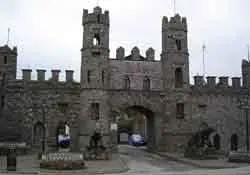
Macroom is a market town about 20 miles to the west of Cork. It is dominated by the walls of Macroom Castle which is in the centre of the town.
It is an elegant, striking stone building with arches, cannons and towers.
The castle is believed to have been built around the time of King John. Over the centuries it has been occupied by the Carew clan and then the McCarthys before Oliver Cromwell and his troops gained control.
The town of Macroom is a popular place for visitors to escape the hustle and bustle of Cork for a day with activities such as fishing, golf and hiking in the nearby hills.
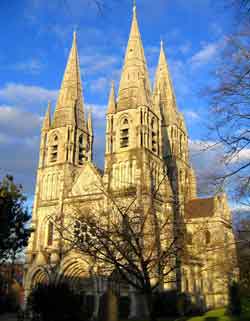
St Fin Barre’s Cathedral
St Fin Barre’s Cathedral is a stunning building built by the Church of Ireland and named after the patron saint of Cork.
The cathedral was designed by Victorian architect, William Burges. It was his first major work and was built between 1863-75. It is an early French gothic style with three spires and several statues.
The inside of the cathedral is equally striking and features impressive paintings, pillars and stained glass.
It is open on Monday to Friday between 9.30 am and 5.30 pm.
Cork nightlife
There is a big choice of things to do in Cork after the sun goes down. There are plenty of pubs and bars that cater for all kinds of tastes. There are numerous traditional local pubs, sports bars and bars with live bands.
You can see all types of music in Cork from traditional folk to jazz to heavy metal. There are also a number of great restaurants with quality food from all over the world.
There are also places to take in a show such as the Everyman Palace Theatre or the Cork Opera House.
Click here for videos taken with a drone-cam that give a bird’s eye view of Cork
Click here for a unique video of Cork taken from a cyclist’s perspective
holidays.html